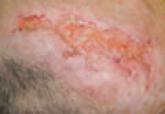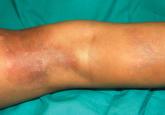Article

Trigeminal Trophic Syndrome: Report of 3 Cases Affecting the Scalp
Trigeminal trophic syndrome (TTS) is a rare condition that results from a prior injury to the sensory distribution of the trigeminal nerve....
Lindsey B. Dolohanty, MD; Steven J. Richardson, MD; David N. Herrmann, MB BCh; John Markman, MD; Mary Gail Mercurio, MD
Dr. Dolohanty was from the Department of Dermatology, Washington University School of Medicine/Barnes-Jewish Hospital, St Louis, Missouri, and currently is from the University of Rochester, New York. Dr. Richardson is from the Department of Dermatologic Surgery, University of Texas Southwestern Medical Center, Dallas. Drs. Herrmann, Markman, and Mercurio are from the School of Medicine and Dentistry, University of Rochester. Dr. Herrmann is from the Department of Neurology, Dr. Markman is from the Department of Neurosurgery, and Dr. Mercurio is from the Department of Dermatology.
The authors report no conflict of interest.
Correspondence: Lindsey B. Dolohanty, MD, 990 South Ave, Ste 206, Rochester, NY 14620 (lindsey_dolohanty@urmc.rochester.edu).

We present the case of a 49-year-old woman with trigeminal trophic syndrome (TTS), also known as trophic trigeminal neuralgia, trigeminal neurotrophic ulceration, and/or trigeminal neuropathy with nasal ulceration. Our case represents an uncommon report of intractable itching and chronic pain associated with TTS. Emphasis was placed on skin biopsy histology, which revealed no neuronal innervation of the affected scalp despite reports of intractable itching and chronic pain. Trigeminal trophic syndrome of the V1 branch of the trigeminal nerve secondary to herpes zoster (HZ) with correlated histology is described. This article provides a discussion of TTS and correlated histology as well as a brief discussion of intractable itching and postherpetic neuralgia.
Practice Points
Case Report
A 49-year-old woman presented to the dermatology department with a concern of itching distributed along the V1 branch of the trigeminal nerve on the left frontoparietal scalp following a herpes zoster (HZ) outbreak in the same dermatome 2 months prior. She initially presented to the emergency department 2 months earlier with vesicular lesions distributed along the V1 branch of the trigeminal nerve, along with facial swelling, periorbital edema, inability to open the left eye, and “excruciating” pain. Her left eye was “itchy” but no ophthalmologic pathology was noted on examination. She was diagnosed with HZ and was treated with valacyclovir and prednisone. Oxycodone-acetaminophen followed by hydromorphone was prescribed for the severe pain with limited benefit. After completing treatment with valacyclovir, oral gabapentin was added for additional pain management, with an initial dose of 100 mg 3 times daily.
At the current presentation, the patient reported profound pruritus in the left frontoparietal scalp region that was intractable and debilitating. Some improvement of the itching was achieved with scratching that resulted in deep ulcerations of the scalp with moderate associated pain. In addition to the prior HZ outbreak, her medical history was remarkable for recurrent lymphoma, uterine cancer, chronic bronchitis, depression, hypothyroidism, osteoarthritis, and primary varicella-zoster virus infection in childhood. Her current medications included oral gabapentin (600 mg 3 times daily), diphenhydramine, levothyroxine, simvastatin, and topical ointments for itching.
On dermatologic evaluation, the patient rated her pain as a 5 on a 10-point scale of intensity. Alopecia involving the left frontoparietal scalp with a 2×3-cm ulceration in a geometric pattern with surrounding erythema was noted (Figure 1A). There also was hyperpigmentation on the forehead distributed along the V1 branch of the trigeminal nerve (Figure 1B). The patient also had been seen in the pain clinic where examination revealed sensory loss to both light touch and sharp stimulus along the left V1 branch of the trigeminal nerve. Visual fields were full, ocular movements were intact, and the face was symmetric with lower cranial nerves intact.
| Figure 1. Alopecia involving the left frontoparietal scalp with a 2×3-cm ulceration in a geometric pattern with surrounding erythema (A). Hyperpigmentation distributed along the V1 branch of the trigeminal nerve due to postinflammatory changes following herpes zoster infection in the same dermatome (B). |
A diagnosis of trigeminal trophic syndrome (TTS) with chronic pain and pruritus due to a complex sensory neural disorder associated with HZ reactivation was made. Treatment included an increase in the dosage of oral gabapentin (1200 mg 3 times daily), oral oxycodone (5 mg every 4 to 6 hours as needed), and sphenopalatine ganglion block on the left side in an attempt to decrease pain and pruritus. At 6-week follow-up, the patient had no improvement in symptoms.
Three scalp punch biopsies were performed on presentation to the dermatology clinic including 2 from the affected area on the left frontoparietal scalp, and one from normal skin on the right side to assess the small nerve fibers affected. Protein gene product 9.5 (PGP 9.5) immunostaining was performed to assess epidermal nerve fiber density. The left scalp biopsies were consistent with a complete focal sensory neuropathy affecting sensory and autonomic axons (Figure 2A). The right scalp biopsy revealed well-innervated skin (Figure 2B).
| Figure 2. Fluorescent labeling with protein gene product 9.5 allowed for comparison of epidermal small nerve fibers on the affected (left) and unaffected (right) sides of the scalp. A biopsy of the left side of the scalp was consistent with a complete focal sensory neuropathy affecting sensory and autonomic axons, and complete absence of epidermal nerve fibers and subepidermal nerve plexus were seen (A)(original magnification ×20). On the right side of the scalp, well-innervated epidermal nerve fibers (white arrows) and subepidermal nerve plexus (green arrow) were seen (B)(original magnification ×20). |
One year after the original HZ outbreak, the patient continued to have debilitating pruritus and pain in the affected dermatome. On physical examination at 1-year follow-up, the hyperpigmentation on the left side of the forehead showed minimal improvement. The ulcerations were healed, but excoriations were noted in the area. Having experienced some relief from titration of the dose of gabapentin 800 mg 3 times daily and doxepin 25 mg nightly at 1-year follow-up, the patient returned to work but remained highly distressed by her symptoms. Neurosurgery was consulted for possible balloon rhizotomy of the left trigeminal nerve, which she ultimately refused due to concerns about side effects.
Comment
Trophic trigeminal syndrome is characterized by unilateral ulceration of the face with anesthesia, paresthesia, and a crescent-shaped erosion or ulcer.1,2 It is one of 2 causes of self-induced facial ulcerations, the other being factitial dermatitis.1,3,4 A 2008 retrospective medical chart review and report of 14 cases helped elucidate the epidemiology of TTS.2 In this case series, the female to male ratio was 6 to 1, and the mean age of TTS onset was 45 years (age range, 6–82 years). The cause of disease in most patients was iatrogenic and the latent period to onset ranged from days to almost one decade. Most patients self-manipulated the face (n=9), and most ulcers affected the second trigeminal division. Pain intensity was severe in most (n=6), and gabapentin offered relief in only 2 cases.2

Trigeminal trophic syndrome (TTS) is a rare condition that results from a prior injury to the sensory distribution of the trigeminal nerve....

We report the case of a 5-year-old girl who presented with 2 blue-red atrophic plaques on the left leg as well as subcutaneous nodules that were...
